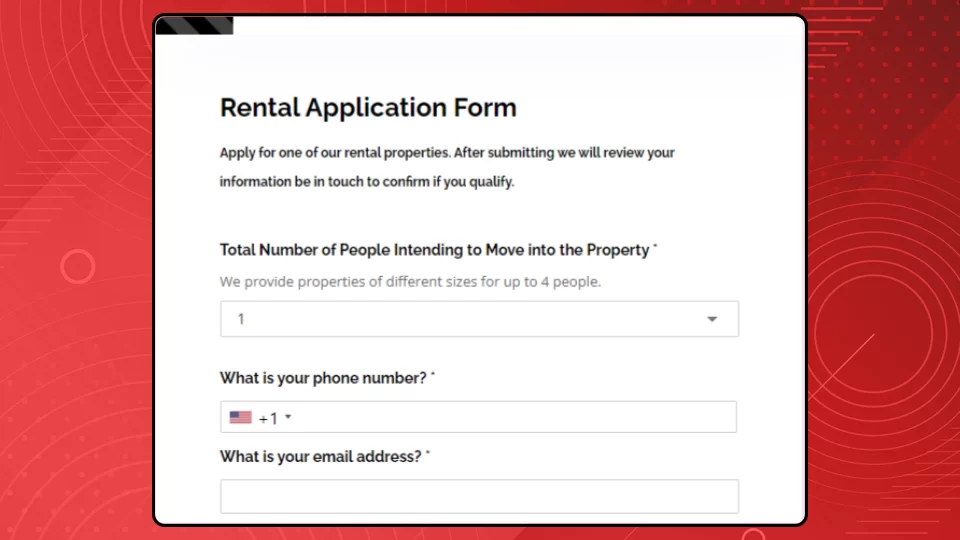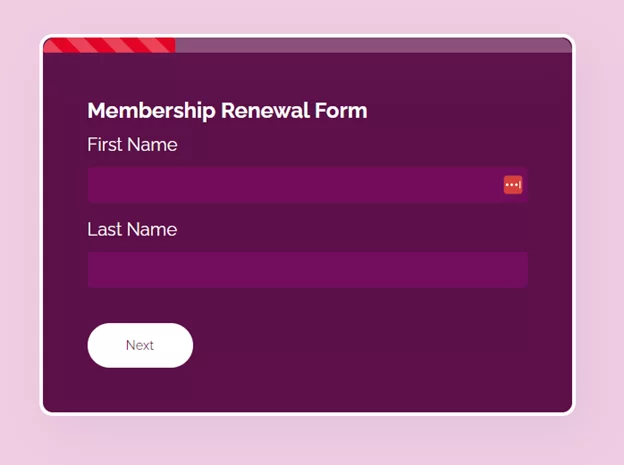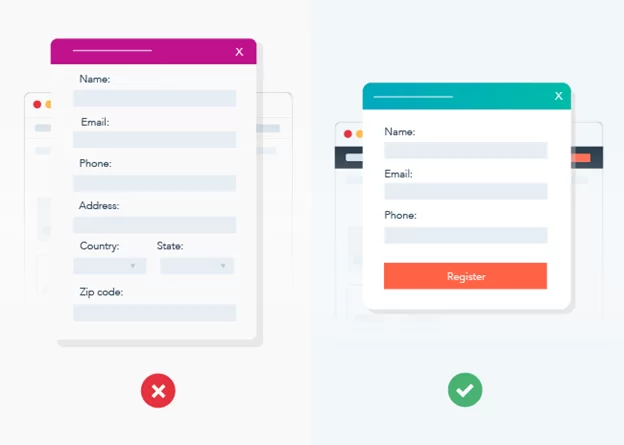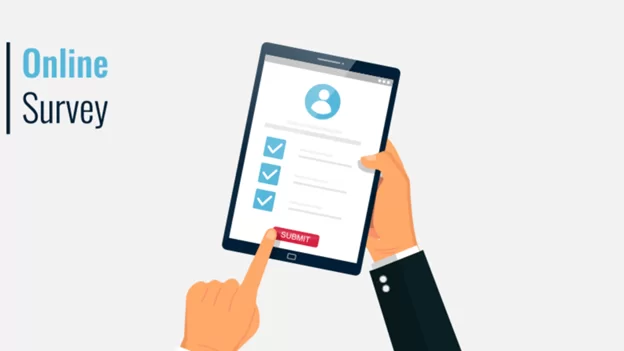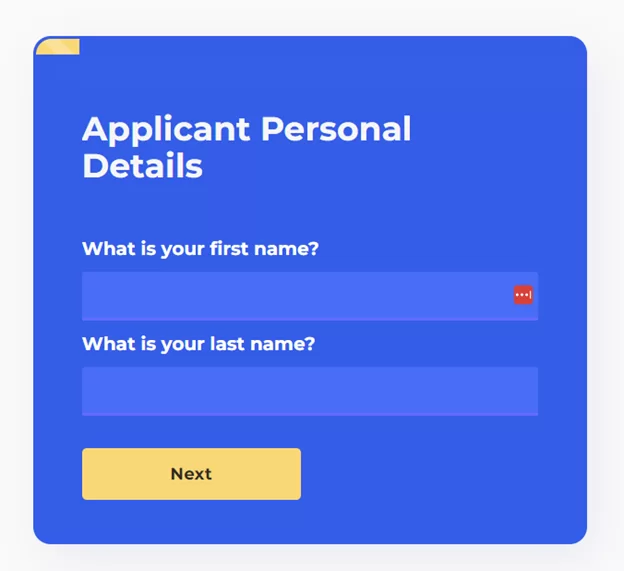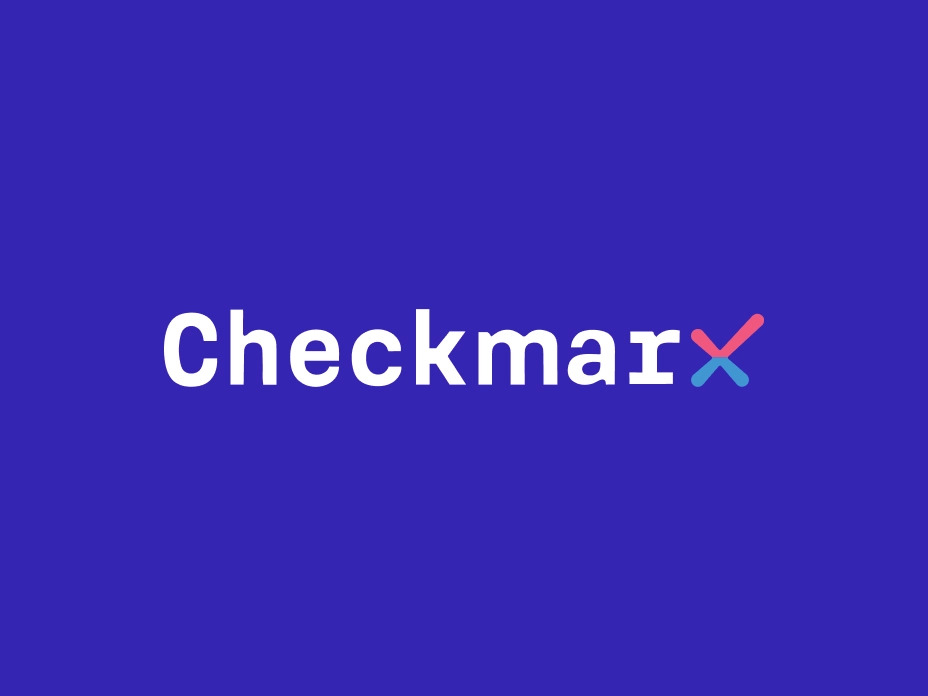Ultimate Guide on Application Forms
Introduction
Application forms collect information from businesses and people looking for work. Filing a form is the initial and final stage of practically every activity you make on the internet, whether it's joining a social media site, completing e-commerce credit card transactions, or registering for a financial product inside an online banking system.
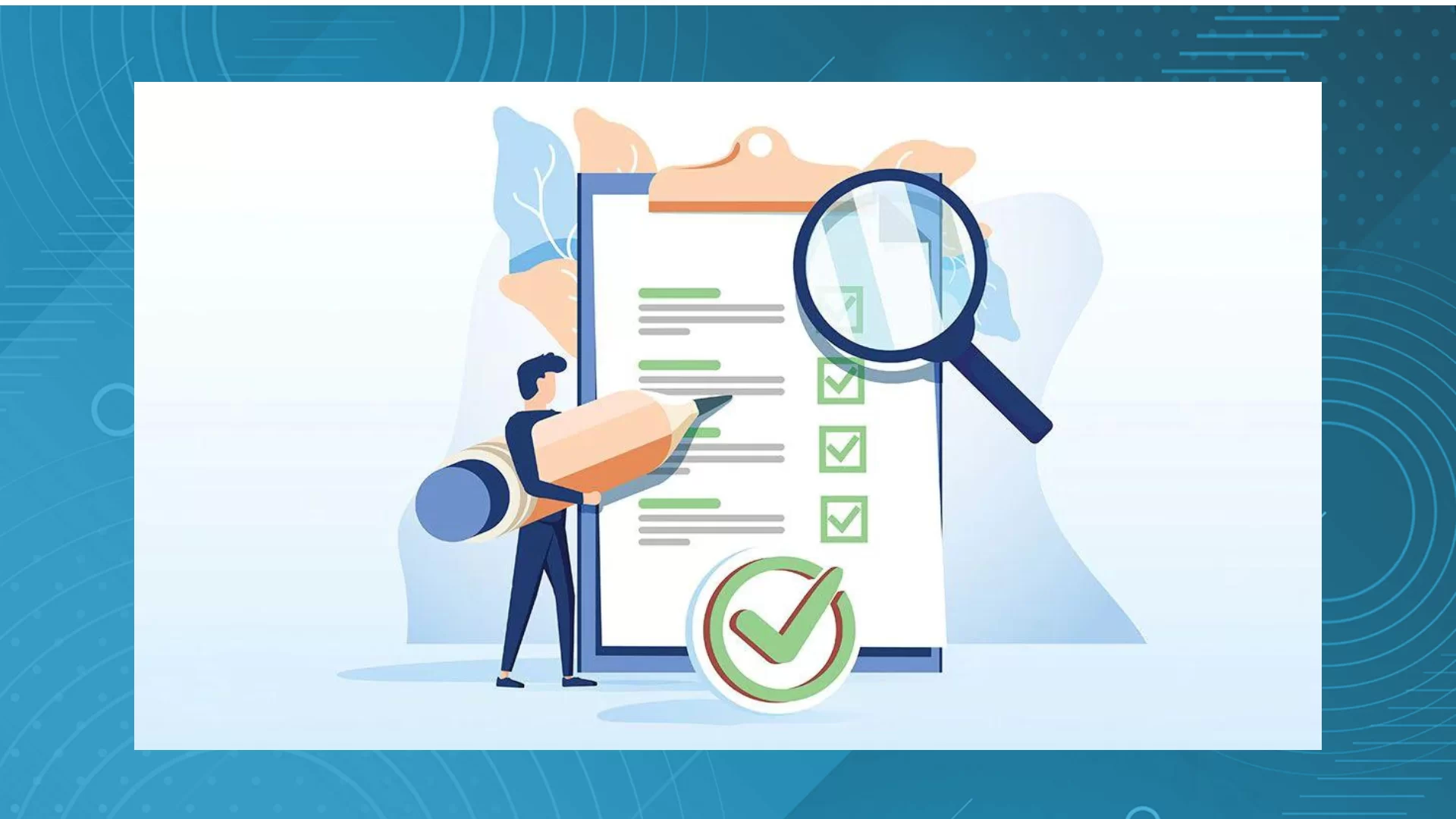
Application forms collect information from companies and job seekers.
The breadth of data required by your form varies depending on the industry. Regardless, I'd be willing to bet that most of them, particularly in FinTech or FinTech software companies, are deeply anchored in an offline setting. These forms are typically used by financial firms and need a plethora of specialized data types.
However, simply converting the form to a digital version is insufficient. The procedure might still be as long and difficult as it was before. Given that the form is the final barrier the user must overcome before achieving their goal, you should concentrate on enhancing the form's user experience until it is quick, fluid, and efficient.
A fantastic experience, on the other hand, does not happen in a vacuum. When you think about the form design process, you quickly see several elements that need to be improved. By minimizing cognitive burden and quickening the user's progress through the form, you should assist the user stay focused and aware.
What are Application Forms?
An application form is a document used to gather information from an individual or organization. It is typically used to apply for a job, a loan, a rental property, a membership, or an educational program.
Application forms typically include personal information, such as the applicant's name, contact information, and qualifications. It may also ask for information about the applicant's work experience, income, assets, and credit history. Some forms may also include a section for the applicant to provide documentation, such as a resume, ID, or proof of income.
Application forms are used by employers, landlords, financial institutions, and other organizations to assess the applicant's qualifications and to make a decision about whether to approve the application. The form may also be used to collect a fee for the application process and to provide the applicant with the terms and conditions of the job, loan, or other opportunities.
Online application forms are becoming increasingly popular as they allow for faster and more efficient processing of applications and a more convenient way for applicants to submit their applications. It is important to make sure that the online form is secure and complies with laws and regulations for data protection and anti-discrimination.
Best practices for creating an Application Form
It is critical to follow best practices for application forms, in addition to excellent practices for online forms. This will allow you to simplify the application process while decreasing applicant mistakes. It will also boost your chances of locating the right individuals. The following are the recommended practices for developing application forms:
A) “One thing per page” approach
Dividing long and complex application forms, such as those used in FinTech (e.g., insurance or loan application forms), into numerous smaller portions is a typical approach to lowering the user's cognitive burden.
Presenting smaller, semantically matched pieces aids the user in maintaining a focus on a single job and the chunk of information requested. We may keep the user continually updated about their place inside the application flow by presenting the form as a multi-step procedure. They can also simply swap between phases if necessary.
The "one thing per page" method significantly simplifies error correction as compared to accordion panels, for example. Accordion panels have their uses, but when you start scrolling through them looking for errors, they may become distracting.
B) Optimizing Application Form Labels
A label is a word or phrase displayed above or next to a form field that informs the form user of its function. You may make these labels more effective by keeping them brief and to the point.
C) Minimizing Dropdowns
The dropdown should be used as a UI element when there are more than 5 things to pick from at some point in the form, according to the general rule. Otherwise, radio buttons or segmented controls can easily substitute dropdowns. Presenting all available options to the user without concealing them in a dropdown improves scannable, which has a significant influence on user performance and efficiency.
D) As much as possible, make your application form mobile-friendly
Many applicants will fill out your form on their smartphone or tablet, so make it simple to increase completion rates. Tips for making your application form more mobile-friendly include:
a) To eliminate the requirement for scrolling, divide large application forms into shorter pages.
b) Avoid complicated items kinds that don't perform well on mobile devices or can't be displayed on a tiny screen.
c) There are no huge photos. They will almost certainly take too long to load.
d) Long replies that are difficult to enter on a tiny keyboard will diminish completion rates.
E) Allow for file uploads and URLs for resumes, CVs, cover letters, portfolios, and the like
It might be inconvenient for candidates who have previously prepared the paperwork for their employment and school background to have to re-enter it in an application form. Allow candidates to submit documents or link you to an internet place for them rather than filling out form fields one by one.
F) Make your organization's or company's privacy policies explicit
Make careful you express (and then follow) clear procedures for acquiring personal information from candidates. Add something like, "We take security seriously and will never sell, rent, or give your personal information away." If any of your application form visitors are from the EU, you must also ensure that your application form is GDPR compliant.
G) Optimize your CTA
A strong call to action will improve the number of people who complete your application form. Optimize the colors to make the application form stand out and utilize action wording like "Send" or "Apply Now" to promote submission.
H) Don't assume that candidates want to hear from you in the future
You develop trust and a good reputation by allowing candidates to accept to receive your email notifications. Include an opt-in (rather than an opt-out) option by including a checkbox after the application form with a choice such as "Agree to receive emails." You can then use the conditional logic of the Notification to send an email only when the result has that response.
I) Optimize Success Pages
Following a successful application, visitors should be notified that their application has been received. However, your Success Page may do far more than simply state, "We have accepted your application." The sort of application form you build will determine how you optimize your Success Page.
Depending on the objectives of your application form, your Success Page may link candidates to a landing page on your website. You may also send candidates to other pages on your website based on their application form responses. For example, if a university candidate specifies "theatre" as a major, your Success Page can send them to the Theater page. Whatever you decide to add to your Success Page, keep it brief, to the point, and mobile-friendly.
J) Allow candidates to save and return their application form
Some applications are brief (for example, a community garden volunteer application), while others are lengthy (like a college application or mortgage prequalification application). Encourage more conversions by offering visitors the choice to store their progress and return, regardless of length.
Benefits of Application Forms
We've previously touched on some of the benefits of application forms, but in this portion of the post, we'll go through the benefits of utilizing application forms in the recruiting process in further detail.
A) Make it easy to compare applicants
In addition to being able to ask more in-depth questions, recruiters may do quick comparisons across candidates to determine who moves forward and who does not. Recruiters can compare applicants' education, talents, and experience. This saves the company a significant amount of time and money because no time or money is wasted on face-to-face interviews.
B) Improve your candidate's knowledge
Using application forms, recruiters may learn significantly more about candidates than they might from a CV or cover letter. Recruiters might ask specific questions about the information required for the post.
C) Background investigations
A background check on applicants may be performed very early in the recruiting process. It is usually preferable to do background and screening checks prior to inviting candidates in for interviews since it saves time and energy if someone is inappropriate for the post.
If the checks come back unfavorably later in the recruiting process, recruiters who run them at the end of the process will have already wasted precious and important time organizing and interviewing applicants. Employers may also need to conduct exclusion screening to ensure that a candidate has not been barred from participating in federal or state programs due to past misconduct or violations.
D) Consistency
Because all candidates answer the same set of questions on application forms, you may gain unbiased insights into them. This enables recruiters to evaluate all candidates on a level playing field.
E) Flexibility
One of the benefits of using an application form is that you may ask any questions you like. So, if recruiters want to know more about their experience and previous job, the queries might be more detailed. Many recruiters enjoy asking competency-based questions on application forms. These are inquiries about previous behavior in roles that may be relevant to the present role in question. More competency-based or behavioral-based interview questions may be found here.
Who uses Application Forms?
Employers use them most frequently in the public sector since the goal is not to sell paper but to ensure a methodical means of comparing applicants. Anyone seeking a job in a local or central government school can expect to fill out an application form for each job. The military also enjoys difficult application forms that put candidates through their paces before they even get to the assault course portion of the evaluation.
Furthermore, many major commercial businesses utilize standard job application forms since they can be processed much faster than CVs, which might come in a variety of formats. If a corporation hires individuals in batches, such as for a graduate program, it may create an application form with particularly specific questions for this job. It's also not uncommon for a corporation to request an application form in addition to a CV.
Why do they use them?
In addition to utilizing application forms to demonstrate that they are efficiently employing taxpayers' money in recruiting concerns, some companies utilize them to gather the information that would not be readily supplied in a CV.
As a result, schools–and any other organizations that work with children or vulnerable adults–will ask about prior criminal convictions and demand a detailed job history to ensure there are no gaps where a candidate may have been hiding in prison.
Employers also use application forms to measure motivation and to provide a preliminary assessment of essential abilities such as spelling, grammar, and punctuation (hence why spell-checking your application before you click send is so important).
Q/A
1. What information do I need to provide on an application form?
Despite the numerous format differences based on the company and industry, application forms often cover the same ground:
a) Your personal information
b) Your work experience
c) Your educational background
d) Reasons why you are a good fit for the job
e) References
2. How do I fill out an application form correctly?
a) Read the instructions carefully: Make sure you understand the requirements and the information you need to provide.
b) Gather all necessary information and documents: Have your personal information, documents, employment history, educational background, and any other relevant information handy.
c) Complete the form accurately: Fill in the form with accurate and up-to-date information. Double-check that all the spelling and grammar are correct. To ensure that, a grammar checker tool can come in handy.
d) Answer the questions completely: Make sure you provide enough information to give a clear picture of your qualifications and experience.
e) Provide additional documentation if required: Some applications may require you to attach a resume, cover letter, or proof of income. Make sure to read the instructions carefully to see what is required.
f) Sign and date the form: Some forms may require a signature and date to certify that the information provided is accurate.
g) Submit the form: If the form is an online form, make sure you submit it properly. If it's a paper form, make sure it is submitted to the correct address.
By following these steps, you can ensure that you fill out the application form correctly and increase your chances of having your application considered.
3. What should I do if I make a mistake in my application form?
If you make a mistake on your application form, here's what you can do:
a) Review the form: Check the form carefully to identify the mistake and correct it.
b) Contact the organization: If you're unsure about how to correct the mistake, you can contact the organization that provided the form and ask for clarification.
c) Submit a corrected version: If you can make the correction yourself, submit a corrected version of the form to the organization.
d) Explain the mistake: If you submit a corrected version, be sure to explain the mistake in a cover letter or note.
e) Be honest: If you made a mistake, be honest and upfront about it. Explain what you did to correct the mistake and why it happened.
It's important to correct mistakes in your application form as soon as possible, as errors or omissions may negatively impact the evaluation of your application. By taking quick action to correct the mistake and providing an explanation, you can show that you are responsible and take the process seriously.
4. Can I submit my application form online?
It depends on the organization that is accepting the application form. Many organizations have moved to online forms in recent years, as they can be more convenient and efficient for both the organization and the applicant.
If the option to submit an application form online is available, you can usually find it on the organization's website or in the application instructions. When submitting the form online, make sure to follow the instructions carefully and provide all the required information.
If you're unsure whether you can submit your application form online or if there are any special requirements, it's a good idea to contact the organization and ask for clarification.
In some cases, a paper form may still be required. In this case, you'll need to print out the form, fill it out by hand, and mail or deliver it to the organization.
5. Do I need to provide references in my application form?
Whether or not you need to provide references in an application form depends on the specific requirements of the organization accepting the form. Some organizations may ask for references as part of the application process, while others may not require them.
If references are required, you will typically be asked to provide the names and contact information of people who can speak to your qualifications, skills, and character. This may include past supervisors, colleagues, or teachers.
It's a good idea to let your references know that you will be providing their information on your application form and to ask for their permission. This can help to ensure that they are willing and able to provide a reference for you when needed.
If references are not required, it's still a good idea to have a list of people who can speak to your qualifications and experience, in case the organization requests them later in the process.
6. What happens after I submit my application form?
After you submit your application form, the process may vary depending on the organization and the type of application. However, here are some common steps that may occur:
a) Review and evaluation: The organization will review your application form and other supporting materials to evaluate your qualifications and determine if you meet their requirements.
b) Interview or assessment: Depending on the organization and the type of application, you may be asked to participate in an interview or assessment to provide more information or demonstrate your skills.
c) Decision-making: The organization will use the information from your application form, interview, and other sources to make a decision on your application.
d) Notification: The organization will notify you of their decision, either through email, phone, or mail. If your application is accepted, you may receive additional instructions on next steps.
e) Follow-up: If your application is not accepted, it's a good idea to follow up with the organization to ask for feedback on your application and to find out what you can do to improve your chances in the future.
It's important to be patient and keep track of the status of your application. Different organizations have different timelines for processing applications, so be prepared to wait a few weeks or longer for a decision. If you haven't heard back after a reasonable amount of time, it's a good idea to follow up with the organization to inquire about the status of your application.
7. What should I do if I am asked to provide additional information or documentation?
If you are asked to provide additional information or documentation as part of the application process, it's important to respond promptly and provide the requested materials as soon as possible.
Here are some steps to follow if you are asked to provide additional information:
a) Review the request: Carefully read the request to understand exactly what the organization is asking for and what they need from you.
b) Gather the necessary information: Collect all of the necessary information and documentation, including any forms, transcripts, letters of recommendation, or other materials that may be required.
c) Check for accuracy: Before you submit the additional information, double-check it to make sure that it is accurate and complete.
d) Submit the information: Submit the additional information to the organization as instructed. Be sure to follow any specific instructions or deadlines provided.
By providing the requested information quickly and accurately, you can demonstrate your commitment to the process and increase your chances of success.
If you have any questions or concerns about the request, it's a good idea to reach out to the organization for clarification. This can help to ensure that you are providing the information they need and can help to avoid any delays or misunderstandings in the process.
8. Can I attach a cover letter or resume to my application form?
Whether or not you can attach a cover letter or resume to your application form can depend on the specific requirements of the organization. Some organizations may require that you submit a separate cover letter and resume in addition to the application form, while others may not.
It's a good idea to check the application instructions carefully to see if a cover letter or resume is required, and to follow the instructions provided. If a cover letter or resume is not required, but you would like to include one, you can ask the organization if they would be willing to accept it as part of your application.
If a cover letter is required, it's important to make sure that it is tailored to the specific position or program you are applying for, and that it highlights your qualifications and experience in a compelling way.
A well-written cover letter and resume can help to supplement your application and provide the organization with additional information about your background and skills. That's why utilizing a resume builder is essential for creating a professional resume that effectively highlights your strengths and improves your chances of getting noticed by employers. By including a cover letter and resume with your application, you can demonstrate your commitment to the process and increase your chances of success.
9. What happens if my application is rejected? What can I do?
If your application is rejected, it can be disappointing, but it's important to understand that rejection is a normal part of the application process. There are several steps you can take if your application is not accepted:
a) Review the decision: Carefully review the reasons for the rejection, if provided. This information can help you to understand what you need to work on or improve in the future.
b) Reflect on your application: Consider what you could have done differently in your application to increase your chances of acceptance. This could include improving your qualifications, providing more detail in your answers, or making your application more relevant to the organization's needs.
c) Seek feedback: If possible, reach out to the organization and ask for feedback on your application. This can help you to better understand what you need to work on, and can help you to prepare for future applications.
d) Re-apply: If appropriate, consider re-applying for the position or program in the future. This can be especially helpful if you have taken the time to address any weaknesses or issues identified in your previous application.
e) Consider other opportunities: If your application is rejected, it may be time to consider other opportunities. This could include exploring different organizations, programs, or positions, or taking additional courses or training to increase your qualifications.
Remember that rejection is a normal part of the application process, and that it's important to stay positive and continue moving forward. With the right approach, you can increase your chances of success in the future.
Final Thoughts
What is the most significant advantage of enhancing user performance and addressing all potential concerns as they fill out a form? Enhanced efficiency. But that's not the only advantage of good application form design. A streamlined user experience will also raise form conversion rates, accelerating your progress toward meeting your business objectives.
Furthermore, if your form requires sensitive information or includes financial transactions, it is critical to make the user comfortable throughout the process. A unpleasant encounter might impact your company's reputation and trustworthiness.


